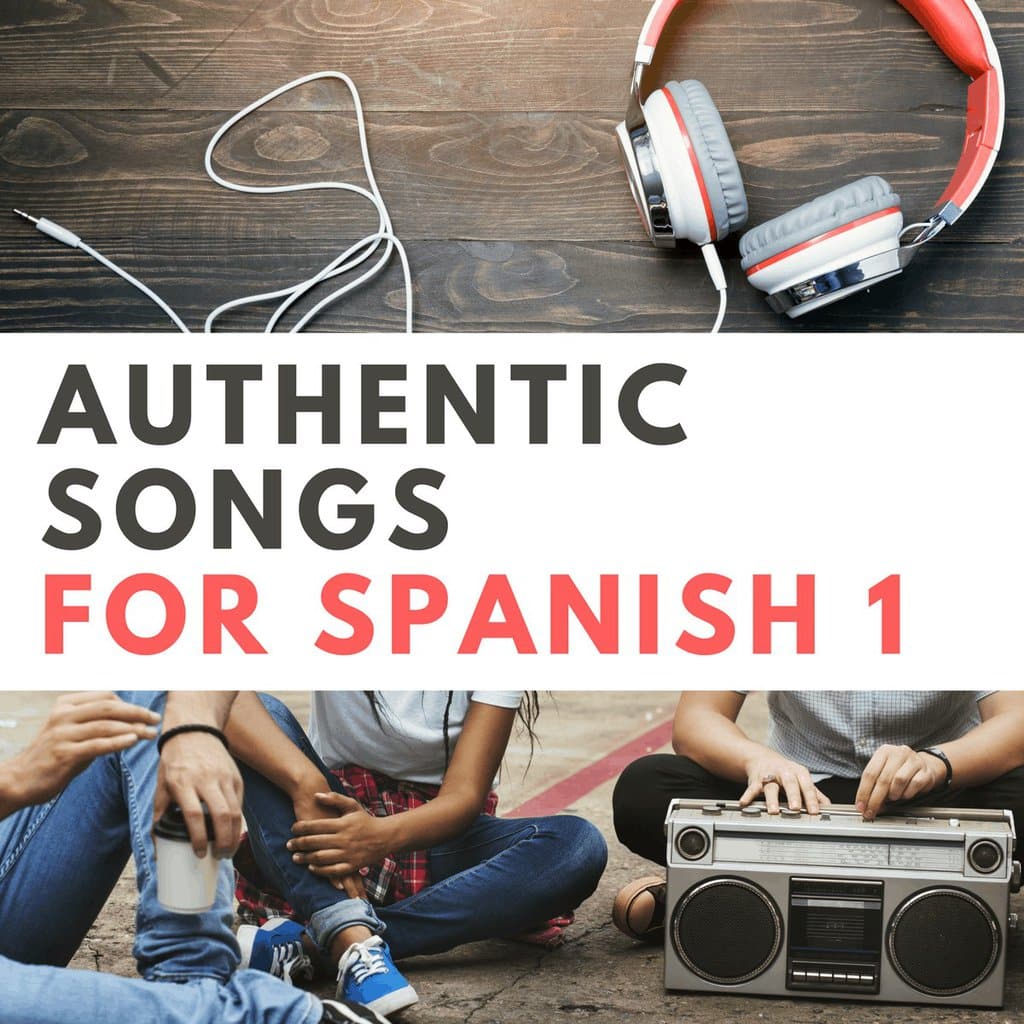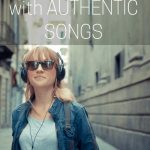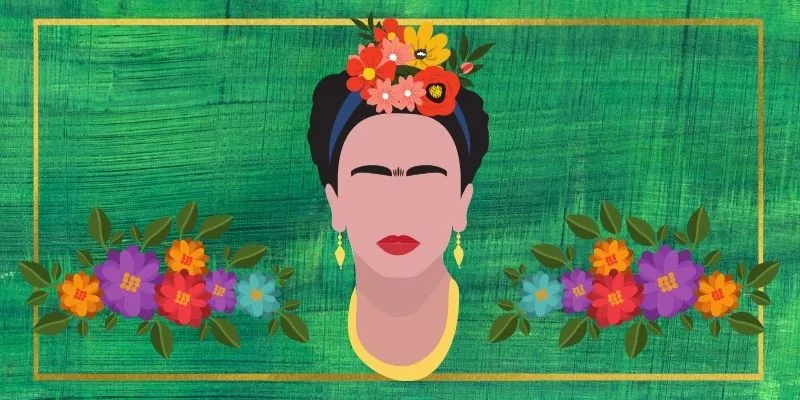How to teach Spanish with Authentic Songs
Inside: How to teach Spanish with authentic music, in the middle and high school classroom.
I didn’t know how to teach Spanish with authentic music, as a new teacher. Fresh from living in Peru and head over heels for the language and culture, I sat down with the textbook. Apparently, for the first half of Spanish I, we would learn classroom objects, articles, greetings, and regular verbs. Hmm. How did authentic songs fit in?
I tried out some of my favorite music in class anyway, but it kind of bombed. We were listening to noise. Extremely catchy noise, but nothing comprehensible. I reverted to grammar songs and conjugation jingles. They were cute, but I was feeding my students the parts: hoping one day all the pieces would come together into the whole language I wanted them to acquire.
Then I finally got that I needed to start with whole, intact, understandable language. Real-life communication is the goal, and songs became more accessible because we were learning high-frequency verbs right away. I saw how comprehensible input and authentic resources could work together. My students could acquire authentic language and real-life skills like getting the gist of a text and picking familiar words out from unfamiliar word. My job was to introduce songs with the language we needed, and find a way to make it comprehensible.
(Just here looking for music suggestions? See my Songs in Spanish by theme and category.)
Update: I was featured on the Language Latte Podcast to share about teaching Spanish with music. Keep on reading or give it a listen!
So, here’s what I wish someone had told me as a newbie teacher:
1. THINK THROUGH THE GOAL.
How will the song connect to your current targets? Will it be a cultural connection? Are you looking to highlight a pattern (present progressive, ir + a, etc.)? Do you want to focus on certain phrases or vocabulary? Here are some huge lists of authentic Spanish songs I came up with for Spanish 1, Spanish 2, and Spanish 2.
2. THINK ABOUT HOW MUCH OF THE SONG CAN BE COMPREHENSIBLE.
How much of the song can you use? I used to get stuck because I didn’t know how to use a song that used many words we didn’t know, or grammar we hadn’t learned. I really think that songs are the best way to hook students to content just above their proficiency level. You can, of course, explain the entire song or provide a translation.
– Some authentic songs can be 100% comprehensible, if you work through them a bit. Very simple songs-perhaps children’s songs- are a great way to see how language works as a whole.
– Some are best because they repeat key phrases. Your students might not understand everything, but esto no me gusta and te estaba buscando get repeated a bazillion times and they never forget those phrases. If you are using a grammar-based approach, this is a good way to help set patterns; if you are CI-based, it helps to cement target structures from a different context.
– For other songs, the verses aren’t the focus, but the chorus can be understand and remembered. Voy a reír, voy a bailar, vivir mi vida, lalala… The chorus is what your students will walk away singing anyway, so in this situation zero in all of your activities on that part.

3. PLAN HOW YOU’LL MAKE THE SONG COMPREHENSIBLE.
How can you bridge the gap from what your students know, to the song? There’s a whole lot more out there than what I’ve done in class, but here are some ideas. This will of course depend on how much of the song you plan to use and teach.
-Pre-teach important vocabulary/phrases.
– Listen to the song and project the lyrics onto the board. Focus on the parts you want them to know, and summarize the parts in between so they get the gist of the lyrics. Circle the phrases you want to emphasize, asking personalized questions to the students. In La bicicleta, for example, Shakira says, puedo ser feliz… I pause there, and we discuss. Students might fill in the blank for themselves (puedo ser feliz… tomando café, sin tarea, etc.) I don’t pause and translate/discuss every line, as that would kill the enjoyment. We will listen to the songs many times, so there is plenty of time to study different parts.
– Create an embedded reading to scaffold the text of the song, or summarize each stanza in simplified language.
– Use the story of the song, and re-write it in simpler terms. If the song video shows the story, they can match the re-written paragraphs to the scenes in the movie.
– Watch the music video if it’s appropriate (preview, preview preview… I speak from experience!), and pause to discuss. Use language the students know to discuss what’s happening and to help them interpret the lyrics.
I think songs are one of the best uses of authentic resources. While most of the time I want class to be comprehensible, music is a good way to get students to take risks and try to derive meaning from something above their level.
4. CREATE SOME ACTIVITIES TO WORK THROUGH THE SONG.
– Try Draw, Write, Check: have your students divide a piece of paper into 4 or 6 parts. Give them a phrase to draw for each part. Then, play the song. Each time they hear the phrase they drew, make a tally mark and check numbers after the song.
– Do an old-fashoined cloze activity. Or, mix it up with movement: students stand up, or do a motion when they hear that term.
– Type up the lyrics on the left side of a paper, and have students summarize each section on the right.
– Ask several questions (Is the singer sad? What does he wish would happen?) Give the students markers to highlight and color code the lyrics that give evidence for the answers.
– Print the lyrics and cut them apart. The students listen to the song and put them in order while listening. Younger students can do this with picture cards or objects (I do this with Los Pollitos Dicen, using scenes from the song, and Un Elefante Se Balanceaba– the students add elephants to a web).
– Do a music bracket with a list of songs, and have your students vote on their favorites over a month, or set period of time.
– Change the voice of the singer from third to first person, or vice-versa.
– Make up actions and sing along!
If you’re looking for an easy activity packet to teach with authentic songs, you may want to check out my bundle:

MORE IDEAS FROM OTHER TEACHERS ON HOW TO TEACH WITH AUTHENTIC MUSIC:
– ¡La música! from Kristy Placido
– What can I DO {-re-mi-fa-so-la-ti-da} with a song?
– Create a PPT with screenshots of the music video, a la MovieTalk like in this example from Kristy Placido
– Música miércoles for using Spanish songs weekly from Mis Clases Locas
Like it? Pin it!







